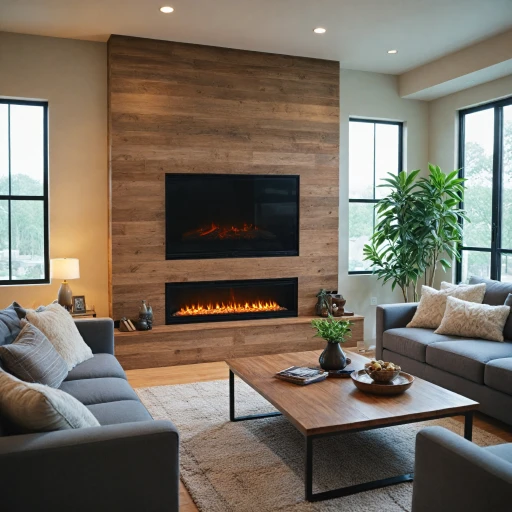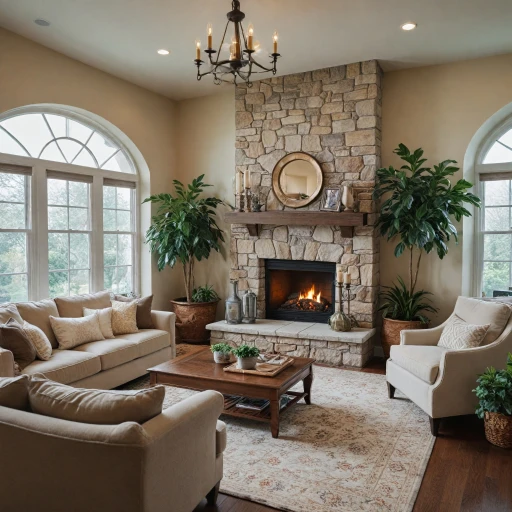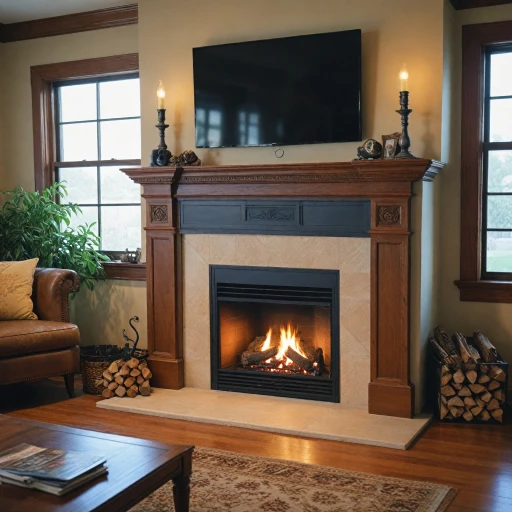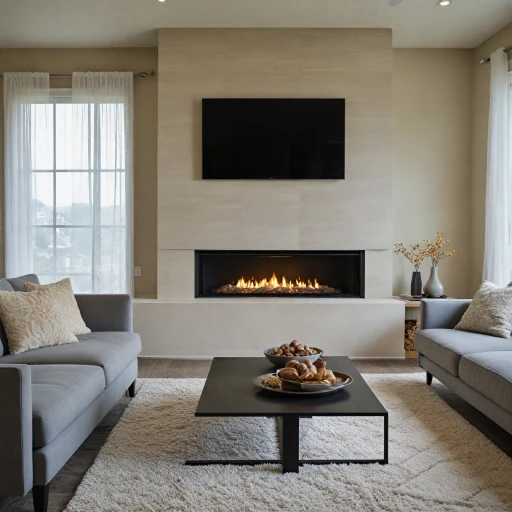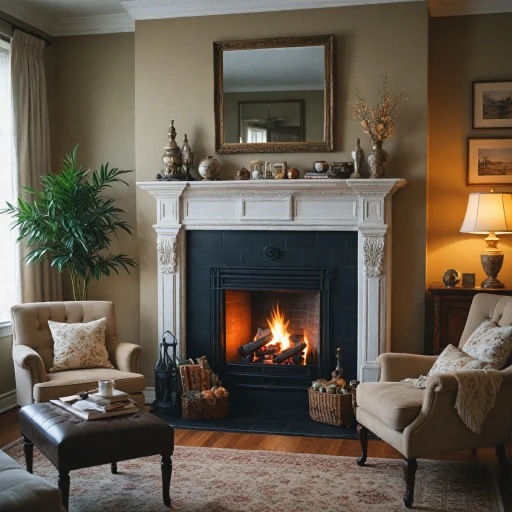
How Electric Fireplaces Work
Getting to Know Electric Fireplaces
Electric fireplaces are a modern marvel, bringing the cozy warmth of a traditional fireplace into your home without the need for wood or gas. They operate by using electricity to power a heating element and a fan, which distributes warmth throughout the room. This setup mimics the ambiance of a real fire, often enhanced by LED lights that create a realistic flame effect.
How They Work
The core components of an electric fireplace include a heating element, a fan, and a flame effect mechanism. The heating element warms up as electricity passes through it, while the fan helps circulate the heat. The flame effect is usually created by LED lights and a rotating reflector, giving the illusion of flickering flames. Unlike gas fireplaces, there's no need for a chimney or vent, making electric models a versatile choice for any room.
Easy Installation and Use
One of the standout features of electric fireplaces is their ease of installation. Most models come ready to use right out of the box, requiring only a standard electrical outlet. This simplicity makes them an attractive option for those who want to add warmth and style to their home without the hassle of a full-scale renovation. Plus, with remote control options, adjusting the heat and flame settings is a breeze.
Safety and Efficiency
Safety is a significant advantage of electric fireplaces. Since there's no real fire, there's no risk of sparks or smoke, making them a safer option for homes with children or pets. Additionally, electric fireplaces are energy efficient, converting almost all the electricity they use into heat, unlike traditional wood or gas fireplaces that lose a lot of heat through the chimney.
For those interested in transforming their traditional fireplace into an electric haven, this guide offers valuable insights.
Benefits of Electric Fireplaces
Perks of Choosing an Electric Fireplace
Electric fireplaces are gaining momentum, and for good reason. They're not just a nifty gadget; they offer several perks that make them stand out.- Ease of Installation: Unlike their gas counterparts, electric fireplaces can be installed in a jiffy with minimal hassle. No messy assembly or dealing with pilot assemblies and gas parts. Just plug in and go!
- Safety First: With no real fire or emissions, they're a great choice for families with kids and pets. Say goodbye to worrying about pilot lights or gas leaks.
- Low Maintenance Costs: Forget about cleaning up ash and soot common with wood or gas stoves. Minimal upkeep is needed.
- Cost-Efficiency: With prices ranging from budget-friendly to luxury, there's something for everyone. Electric fireplaces often come with a sale price tag that beats regular fireplaces.
- Year-Round Use: Use the heat function in winter or just the flame effect for ambiance year-round, unlike the wood stove, which demands actual wood logs for any display.
- Eco-Friendly: Being green is in. Electric fireplaces don't burn any resources, making them more environmentally friendly compared to gas burning or wood fireplaces.
Comparing Electric and Gas Fireplaces
Making the Right Choice: Electric vs. Gas Fireplaces
When it comes to cozying up your home with a fireplace, choosing between electric and gas can be a head-scratcher. Each type has its own merits, and what suits one home might not fit another. Here's a simple breakdown to help make that decision easier.- Safety First: For those with safety concerns, especially in homes with kids or pets, electric fireplaces often take the cake. Unlike gas fireplaces, there's no open flame to worry about, making them a safer option for many families.
- Installation Process: While both require some assembly, electric fireplaces are generally easier to install. They're often a plug-and-use setup, whereas gas options might demand a more involved installation process with parts like pilot assembly and direct vent systems.
- Heat Output: Gas fireplaces typically provide more heat, ideal for those bone-chilling winter nights. Electric fireplaces, however, offer control through adjustable heat settings—great for just taking off the chill without overheating the room.
- Price Point: If you're budget-conscious, electric fireplaces can be easier on the wallet. Their regular price often undercuts gas fireplaces, which might involve extra costs for parts such as remote control or pilot assembly.
- Aesthetic Appeal: Both options now come with a variety of styles, from the rustic charm of a wood stove look to the sleek modernity of a wall-mounted fireplace heater. This means there's something for every décor preference. For further inspiration, consider enhancing your home with a wall-mounted fireplace heater.
Key Features to Look for in an Electric Fireplace
Features to Prioritize for Your Electric Fireplace
When you're in the market for an electric fireplace, selecting the right features can elevate your experience. Let's take a closer look at some aspects you should consider.- Heat Output and Efficiency: Check the heat output, as this determines how effectively the fireplace can warm up your space. Electric fireplaces often come with adjustable heat settings, letting you control the temperature to your liking.
- Customization Options: Many modern fireplaces offer customizable flame effects. You can choose from traditional fire looks to more modern displays, giving you the ability to match your room's ambiance.
- Control Mechanisms: Remote controls are a standard offering, providing convenience and ease. Higher-end models may include smart home compatibility, allowing you to operate them through voice commands or smartphone apps.
- Safety Features: Always check for overheat protection and cool-touch glass. Since electric fireplaces are not burning real flames, they tend to be safer than traditional options, yet these features add an extra layer of security.
- Cost and Installation: Prices range depending on features and brand. While some models may have a higher sale price, they could save you money on energy bills in the long run. Consider any necessary assembly or the possibility of needing a service to install it.
Common Issues and Troubleshooting Tips
Resolving Common Electric Fireplace Issues
Electric fireplaces, much like their gas and wood stove counterparts, bring warmth and ambiance to any home with the flick of a switch. However, while they are generally low-maintenance, there are some common issues that users might face. Here's a rundown of typical problems and their solutions, ensuring your unit provides effective heat and glow all year round.
No Heat Output
One of the most common issues is when your electric fireplace won't emit heat. Here are some steps you can take to resolve this problem:
- Verify that the unit is plugged in properly and that the power supply is intact.
- Check the thermostat settings on your remote control and make sure it's set to a higher temperature than the current room temperature.
- Ensure that the unit is not in "flame-only" mode, which provides the visual appeal without the heat.
- If the above don't work, check for any tripped circuit breakers or blown fuses in your main electric panel.
- Inspect the heater element for burn-out or damage. In this case, you might need to contact the manufacturer for replacement parts.
Visual Flame Appearance
Sometimes the fire effect in your electric fireplace might appear dim or not function at all. Troubleshooting tips include:
- Check that none of the bulbs that contribute to the flame effect are burnt out. Replacement parts can often be purchased online or at stores where these units are on sale.
- Inspect the element and connections that control the flame display. Loose or disconnected wiring may affect the effect.
- Consult the manual that came with your fireplace for instructions on assembly and specific troubleshooting steps related to your unit's model.
Fan Functionality
A malfunctioning fan can lead to inadequate heat dispersion:
- Ensure the fan isn't obstructed by any objects or debris.
- Listen for any strange noises. This might indicate a problem with the fan motor or buildup of dust.
- Regular cleaning of the fan and its components can prolong the fan's life.
Remote Control Issues
If your remote control isn’t working:
- Change the batteries in the remote control.
- Make sure you're within range of the fireplace's sensor.
- If the issue persists, consult the user manual for further troubleshooting or add to cart a replacement remote from reputable sources.
Keeping these tips in mind will ensure your electric fireplace remains a reliable source of warmth and beauty. When in doubt, always refer to your user manual or reach out to the manufacturer for further assistance to maintain your fireplace in top shape.
Maintenance Tips for Longevity
Prolong the Life of Your Electric Fireplace
Regular maintenance truly goes a long way in keeping your electric fireplace running smoothly and ensuring it stands the test of time. Let's go over the essentials that can help extend the lifespan of this cozy source of warmth.- Dust and Debris Control: Giving your electric fireplace a quick wipe down every now and then helps keep dust from accumulating. Focus on the fireplace parts where dirt tends to settle, including the heater and control areas.
- Inspect and Replace Parts: Like any electric device, certain components might need a little refresher over time. Keep an eye out for any signs of wear and tear. If the display or heater shows signs of malfunction, it's advisable to check the parts and potentially replace them.
- Regular Check on Electrical Components: Ensure the power cord and any connections are in good condition. If you notice any fraying or damage, it's smart to get those replaced to avoid any sudden surprises when you hit the "on" switch.
- Keep Ventilation Points Clear: Ensure all vents and openings are unobstructed to maintain a steady and efficient heat flow. This is much the same as any heat-emitting device, similar to a gas stove or wood stove.
- Remote Control Maintenance: Don't forget that even the remote control could use some attention. Change the batteries regularly and clean off any dust or grime that might affect its functionality.
- Consult the Manual for Troubleshooting: When in doubt or faced with a stubborn issue, flip through your user manual for troubleshooting tips specifically suited to your model, as this can save you on repair costs.

